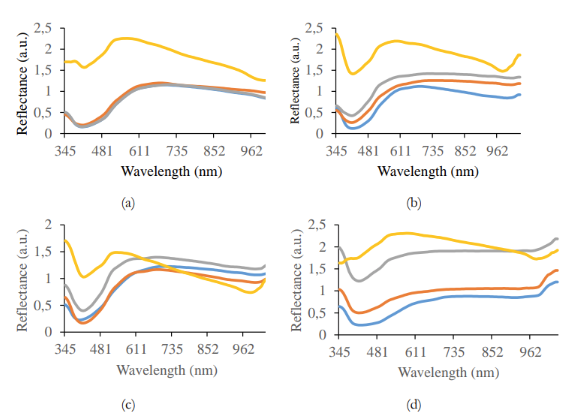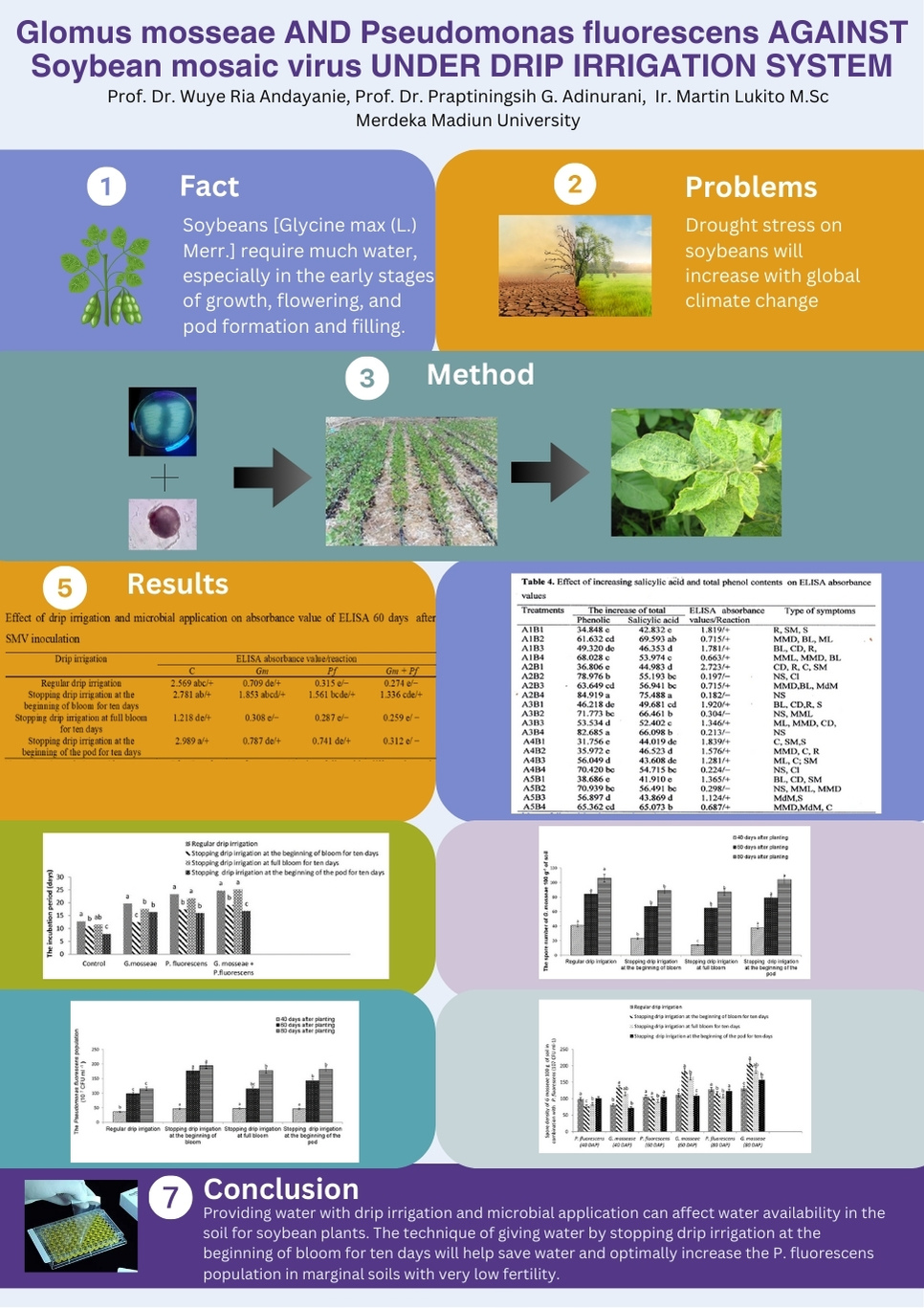EVALUATION OF INDONESIAN LOCAL SOYBEAN BASED ON CHEMICAL CHARACTERISTICS AND VISIBLE - NEAR INFRARED SPECTRA WITH CHEMOMETRICS

Soybean characterization is essential to ensure product quality during distribution according to internal values. In this context, non-destructive characterization method, such as spectroscopy, offer an effective and efficient approach to testing soybean quality in field applications. Among the instruments that are widely used for testing soybean quality, the semi-portable visible near-infrared (Vis-NIR) spectrometer operating at a specific range of 345 to 1033 nm has been proven effective. Therefore, this study aimed to investigate soybean seeds characterization using Vis-NIR spectroscopy with PCA and PLSR chemometric methods. The investigation was carried out using soybean seeds consisting of eight varieties locally produced on Java Island, Indonesia, including Dega1, Dena1, Deja2, Dering1, Devon1, Yellow Flap, Green, and Detam4, in the form of intact, crumble, flour, and paste. Several quality parameters such as protein, fat, crude fiber, carbohydrate, ash, water, chlorophyll, total carotene, vitamin C, and L*, a*, and b* values were measured across intact, crumble, flour, and paste samples. The results of Principal Component Analysis (PCA) showed that sample form and genotypes affected soybean classification. Furthermore, Partial Least Squares Regression (PLSR) showed adequate model calibration for crude fiber, chlorophyll, total carotene, and vitamin C parameters. Based on this analysis, it could be concluded that Vis-NIR spectroscopy proved to be suitable for the classification and prediction of soybean characterization.
Downloads
Abadi FR, Masithoh RE, Sutiarso L and Rahayoe S. 2022. A study of characterization procedure for non-destructive testing of soybean seed based on spectroscopy. IOP Conference Series: Earth and Environmental Science 1059: 012015. doi: 10.1088/1755-1315/1059/1/012015. DOI: https://doi.org/10.1088/1755-1315/1059/1/012015
Afonso T, Moreco R, Uarrota VG, Navarro BB, Nunes EC, Maraschin M and Rocha M. 2017. UV-Vis and CIELAB Based Chemometric Characterization of Manihot esculenta Carotenoid Contents. J Integr Bioinform 14(4): 20170056. DOI: https://doi.org/10.1515/jib-2017-0056
Alander JT, Bochko V, Martinkauppi B, Saranwong S, and Mantere, T. 2013. A Review of Optical Non-destructive Visual and Near-Infrared Methods for Food Quality and Safety. International Journal of Spectroscopy 2013: 1-36. doi: 10.1155/2013/341402. DOI: https://doi.org/10.1155/2013/341402
Association of Official Analytical Chemists (AOAC). 2007. Official Methods of Analysis of AOAC International (18th ed.). Washington: Association of Official Analytical Chemists.
Berns R.S. 2019. Numerical Color Specification: Colorimetry, in: Billmeyer and Saltzman’s Principles of Color Technology. John Wiley & Sons Ltd Hoboken NJ: 51-84. DOI: https://doi.org/10.1002/9781119367314.ch4
Chandaka M, Kumar SA, Reddy PS, Rajamohitha K, Reddy NS and Sudeshna R. 2012. Quantitative evaluation of carbohydrate levels in different natural food stuffs by UV-visible spectrophotometer. Pharmanest 3(3): 239-242.
Cortés V, Blasco J, Aleixos N, Cubero S, and Talens P. 2019. Monitoring strategies for quality control of agricultural products using visible and near-infrared spectroscopy: A review. Trends in Food Science and Technology 85 (January): 138-148. doi: 10.1016/j.tifs.2019.01.015. DOI: https://doi.org/10.1016/j.tifs.2019.01.015
Farag M A, Sheashea M, Zhao C, and Maamoun AA. 2022. UV Fingerprinting Approaches for Quality Control Analyses of Food and Functional Food Coupled to Chemometrics: A Comprehensive Analysis of Novel Trends and Applications. Foods, 11(18). doi: 10.3390/foods11182867. DOI: https://doi.org/10.3390/foods11182867
Gebregziabher BS, Sheng-rui Z, Azam M, Jie Q, Boateng KGA, Yue F, Yi-tian L, Jing L, Bin L and Jun-ming S. 2022. Natural variation and geographical distribution of seed carotenoids and chlorophylls in 1167 Chinese soybean accessions. Journal of Integrative Agriculture. doi: 10.1016/ j.jia.2022.10.011.
Harsono A, Harnowo D, Ginting E, and Elisabeth DAA. 2021. Soybean in Indonesia: current status, challenges and opportunities to achieve self-sufficiency. In Legumes: Vol. December. doi: 10.5772/intechopen.101264. DOI: https://doi.org/10.5772/intechopen.101264
ILETRI. 2016. Deskripsi Varietas Unggul aneka kacang dan umbi [Description of Legume and Tuber Crops Superior Varieties]. Badan Penelitian dan Pengembangan Pertanian, Kementerian Pertanian.
Jia F, Peng S, Green J, Koh L, and Chen X. 2020. Soybean supply chain management and sustainability: a systematic literature review. Journal of Cleaner Production 255: 120254. doi: 10.1016/j.jclepro.2020.120254. DOI: https://doi.org/10.1016/j.jclepro.2020.120254
Kementan (Kementerian Pertanian). 2020. Outlook kedelai: komoditas pertanian tanaman pangan kedelai [SOybean Outlook: Soybean The Agricultural Commodity of Food Crops] (A. A. Susanti & A. Supriyatna, eds.). Pusat Data dan Sistem Informasi Pertanian Kementerian Pertanian.
Longoni M, Freschi A and Cicala N. 2019. Non-invasive identification of synthetic organic pigments in contemporary art paints by visible–excited spectrofluorimetry and visible reflectance spectroscopy, Spectrochimica Acta Part A: Molecular and Biomolecular Spectroscopy (2019) DOI:10.1016/ j.saa.2019.117907. DOI: https://doi.org/10.1016/j.saa.2019.117907
Lopes EJ, Zepka LQ and Queiro MI. 2017. Chlorophyll. InTechOpen.
Manley M. 2014. Near-infrared spectroscopy and hyperspectral imaging: Non-destructive analysis of biological materials. Chemical Society Reviews 43(24): 8200-8214. doi: 10.1039/ c4cs00062e DOI: https://doi.org/10.1039/C4CS00062E
Masithoh R E, Pahlawan MFR, Saputri DAS, and Abadi FR. 2023. Visible-Near-Infrared Spectroscopy and Chemometrics for Authentication Detection of Organic Soybean Flour. Pertanika Journal of Science and Technology 31(2): 671-688. doi: 10.47836/pjst.31.2.03 DOI: https://doi.org/10.47836/pjst.31.2.03
Mayerhöfer TG, Pipa AV, and Popp J. 2019. Beer's Law-Why Integrated Absorbance Depends Linearly on Concentration. ChemPhysChem 20(21): 2748-2753. doi: 10.1002/cphc.201900787 DOI: https://doi.org/10.1002/cphc.201900787
Monago-Maraña O, Eskildsen CE, Galeano-Díaz T, Muñoz de la Peña A, and Wold JP. 2021. Untargeted classification for paprika powder authentication using visible – Near infrared spectroscopy (VIS-NIRS). Food Control 121(June 2020). doi: 10.1016/ j.foodcont.2020.107564. DOI: https://doi.org/10.1016/j.foodcont.2020.107564
Okoronkwo NE, Mba KC and Nnorom IC. 2017. Estimation of Protein Content and Amino Acid Compositions in Selected Plant Samples Using UV-Vis Spectrophotometeric Method. American Journal of Food Science and Health Vol. 3, No. 3 (2017) p: 41-46.
Pahlawan MFR, Murti BMA, and Masithoh RE. 2022. The potency of Vis/NIR spectroscopy for classification of soybean based of colour. IOP Conf. Series: Earth and Environmental Science, 1018. Yogyakarta: IOP Publishing Ltd. DOI: https://doi.org/10.1088/1755-1315/1018/1/012015
Pahlawan MFR, Saputri DAS, and Masithoh RE. 2023. Non-Destructive Evaluation of Moisture Content in Single Soybean Seed Using Vis-NIR Spectroscopy. Proceedings of the International Conference on Sustainable Environment, Agriculture and Tourism (ICOSEAT 2022) 26: 396-400. DOI: https://doi.org/10.2991/978-94-6463-086-2_52
Riscahyani NM, Ekawati ER, and Ngibad K. 2019. Identification of Ascorbic Acid Content In Carica papaya L. Using Iodimetry and UV-VIS Spectrophotometry. Indonesian Journal of Medical Laboratory Science and Technology 1(2): 58-64. DOI: https://doi.org/10.33086/ijmlst.v1i2.1291
Shi D, Hang J, Neufeld J, Zhao S, and House JD. 2022. Estimation of crude protein and amino acid contents in whole, ground and defatted ground soybeans by different types of near-infrared (NIR) reflectance spectroscopy. Journal of Food Composition and Analysis 111 (2022): 104601. DOI: https://doi.org/10.1016/j.jfca.2022.104601
Walsh KB, Blasco J, Zude-Sasse M, and Sun X. 2020. Visible-NIR' point' spectroscopy in postharvest fruit and vegetable assessment: The science behind three decades of commercial use. Postharvest Biology and Technology 168(April 2019): 111246. doi: 10.1016/j.postharvbio.2020. 111246 DOI: https://doi.org/10.1016/j.postharvbio.2020.111246
Wang M, Xu Y, Yang Y, Mu B, Nikitina MA, and Xiao X. 2022. Vis/NIR optical biosensors applications for fruit monitoring. Biosensors and Bioelectronics: X 11(March): 100197. doi: 10.1016/ j.biosx.2022.100197. DOI: https://doi.org/10.1016/j.biosx.2022.100197
Yang L, Wang S, Zhang H, Du C, Li S, and Yang J. 2022. Effects of black soybean powder particle size on the characteristics of mixed powder and wheat flour dough. LWT-Food Science and Technology 167 (2022) 113834. DOI: https://doi.org/10.1016/j.lwt.2022.113834
Zhu Z, Chen S, Wu X, Xing C and Yuan J. 2018. Determination of soybean routine quality parameters using near-infrared spectroscopy. Food Sci Nutr. (2018): 1-10.
Copyright (c) 2024 Rudiati Evi Masithoh, Farid R Abadi, Prof., Sri Rahayoe

This work is licensed under a Creative Commons Attribution-NonCommercial-NoDerivatives 4.0 International License.
Authors who publish with this journal agree with the following terms:
- Authors retain copyright and grant the journal right of first publication, with the work 1 year after publication simultaneously licensed under a Creative Commons attribution-noncommerical-noderivates 4.0 International License that allows others to share, copy and redistribute the work in any medium or format, but only where the use is for non-commercial purposes and an acknowledgement of the work's authorship and initial publication in this journal is mentioned.
- Authors are able to enter into separate, additional contractual arrangements for the non-exclusive distribution of the journal's published version of the work (e.g., post it to an institutional repository or publish it in a book), with an acknowledgement of its initial publication in this journal.
- Authors are permitted and encouraged to post their work online (e.g., in institutional repositories or on their website) prior to and during the submission process, as it can lead to productive exchanges, as well as earlier and greater citation of published work (See The Effect of Open Access).




























